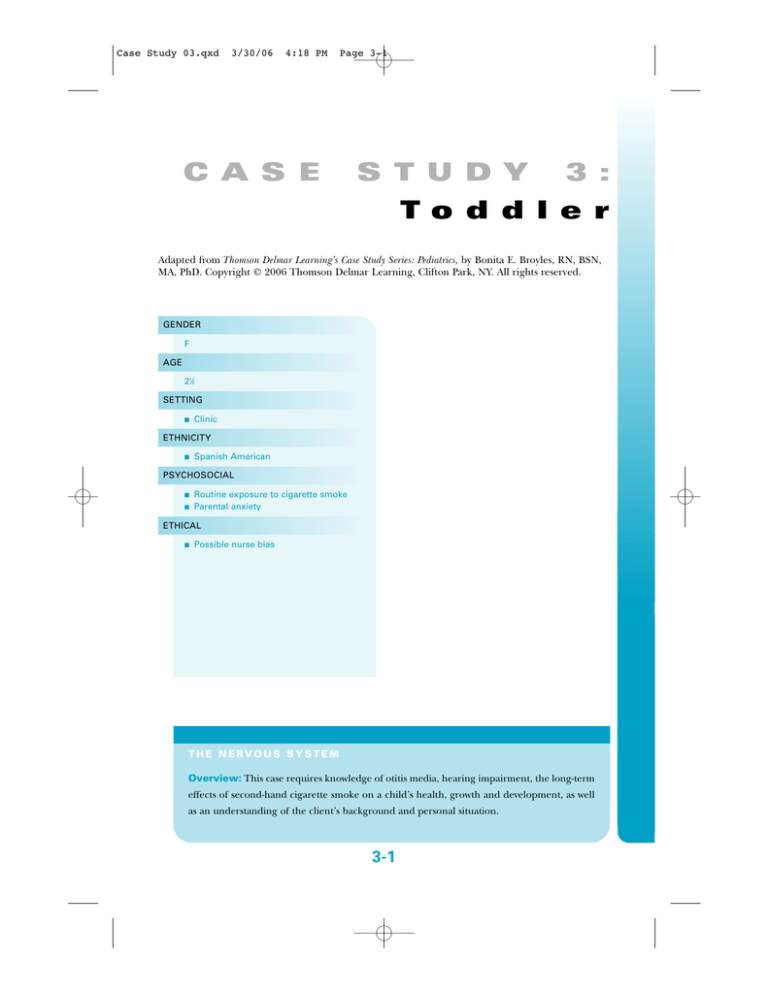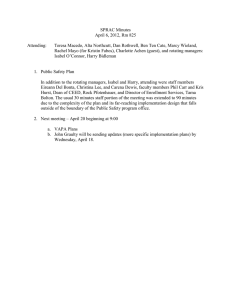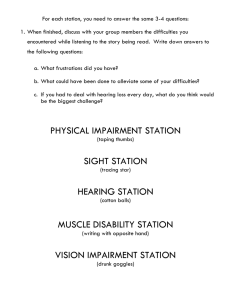
Case Study 03.qxd
3/30/06
4:18 PM
Page 3-1
C A S E
S T U D Y
3 :
T o d d l e r
Adapted from Thomson Delmar Learning’s Case Study Series: Pediatrics, by Bonita E. Broyles, RN, BSN,
MA, PhD. Copyright © 2006 Thomson Delmar Learning, Clifton Park, NY. All rights reserved.
GENDER
F
AGE
21⁄2
SETTING
■
Clinic
ETHNICITY
■
Spanish American
PSYCHOSOCIAL
■
■
Routine exposure to cigarette smoke
Parental anxiety
ETHICAL
■
Possible nurse bias
THE NERVOUS SYSTEM
Overview: This case requires knowledge of otitis media, hearing impairment, the long-term
effects of second-hand cigarette smoke on a child’s health, growth and development, as well
as an understanding of the client’s background and personal situation.
3-1
Case Study 03.qxd
3/30/06
4:18 PM
Page 3-2
3-2
Client Profile
Isabel is a 21⁄2-year-old toddler who lives with her parents and 13-monthold sister in a rural community. Her father is a migrant worker and her
mother stays at home with the children. Both parents are smokers. Both
Isabel and her sister experienced recurrent episodes of otitis media during
infancy although Isabel’s infections have become less frequent. Isabel’s
speech is delayed; however, her mother believes that this is due to her lack
of interactions with other children her age. Their culture and financial situation does not encourage daycare settings for children if the mother can
stay at home with them. Most of Isabel’s speech is not understandable
although she babbles “constantly.” Both children have received their scheduled immunizations at the local pediatric clinic. Isabel is brought to the
clinic by her parents when she places a small toy in her ear that her parents
are unable to remove.
Case Study
During the admission history, Isabel’s mother tells the nurse that she has
had “behavior problems” with Isabel since she was 11 months old although
she stated she had not mentioned this to the staff at the clinic because she
was embarrassed. On further questioning, Isabel’s mother explains that
Isabel “never listens to me and doesn’t even look at me when I talk to her.”
She further states that Isabel doesn’t talk so they can understand her even
though they have friends whose children not only talk all the time, but she
can understand what they are saying. “Isabel’s problems are probably my
fault because I didn’t raise her right. Now I’m afraid she is retarded and
I don’t know how to help her.” Isabel sits in her mother’s lap babbling during the interview and does not make eye contact with her parents or the
nurse during their conversation or when addressed. She appears disinterested in her surroundings.
Questions
1. Discuss the significance of Isabel’s
clinical manifestations.
2. Discuss the relationship between
Isabel’s history of otitis media and her
present condition.
3. What is the incidence of hearing
impairment in children?
4. Discuss the types of hearing
impairment.
5. Discuss Isabel’s mother’s comment
that Isabel “has always been a behavior
problem” and “Isabel’s problems are probably my fault because I didn’t raise her
right. Now I’m afraid she is retarded and I
don’t know how to help her.”
6. What other assessment data would be
helpful for the nurse to have to prepare
Isabel’s care plan?
Copyright © 2007 by Thomson Delmar Learning, a division of Thomson Learning, Inc. Permission to reproduce for classroom use granted.
Case Study 03.qxd
3/30/06
4:18 PM
Page 3-3
CASE STUDY 3: TODDLER
7. What are the priorities of care for
Isabel?
10. Discuss your feelings about parents’
behavior that places their children at risk.
8. Discuss the effects of hearing impairment on Isabel’s growth and development.
11. How could the nurse approach
Isabel’s parents about their cigarette
smoking and how it compromises their
children?
9. Discuss the standards of medical-surgical care for Isabel’s hearing impairment.
Questions and Suggested Answers
1. Discuss the significance of Isabel’s clinical manifestations. Isabel’s clinical manifestations indicate that Isabel is experiencing hearing impairment, probably conductive hearing loss. Her lack of vocabulary and
understandable verbalizations results from her inability to hear sounds and
words to imitate. Her “behavior problems” are probably because she is
unable to hear when her mother speaks to her. Frequently children with
hearing impairment are mistakenly diagnosed with behavior issues because
the manifestations of the two are similar, including ignoring when people
talk, being disinterested in what is going on around them, and inappropriate or immature language development.
2. Discuss the relationship between Isabel’s history of otitis media and her
present condition. Recurrent otitis media is the leading cause of conductive hearing loss. With repeated infections, the middle ear structures lose
their flexibility and become rigid, interfering with the conduction of sound
from the environment.
3. What is the incidence of hearing impairment in children? Approximately
3 in 1,000 neonates are born with hearing impairment. Preterm infants
requiring intensive or critical care have an incidence of 1% to 4% or 10–40
per 1,000 because of the immaturity of the central nervous system and sensory nerves prior to 37 weeks’ gestation. In addition, nerves are the most
sensitive to changes in oxygenation in the body and most preterm infants
born prior to 37 weeks’ gestation experience some degree of respiratory
compromise and impaired gas exchange. According to Lotke, “Hearing
loss occurs in 10 per 1,000 children in the United States. Of these, roughly 1
in 1,000 has profound hearing loss, and 3–5 per 1,000 have mild to moderate hearing loss that may affect language acquisition unless hearing and/or
language are aided. Acquired hearing loss may add 10% to 20% to this figure. Internationally, sensory-neural hearing impairment occurs in 9–27 per
1,000 children.”
4. Discuss the types of hearing impairment. Three types of hearing
impairment have been identified: conductive, sensory-neural, and mixed
Copyright © 2007 by Thomson Delmar Learning, a division of Thomson Learning, Inc. Permission to reproduce for classroom use granted.
3-3
Case Study 03.qxd
3/30/06
4:18 PM
Page 3-4
3-4
(conductive and sensory-neural combined). Conductive hearing loss
occurs when sound cannot be conducted through the middle ear structures. This type of hearing loss is usually mild and temporary. Sensory-neural hearing loss involves the malfunction of the cochlea in the inner ear as
a result of the damage or destruction of the tiny hair cells. The term neural
means nerve, so this type indicates damage to the auditory nerve that relays
messages from the cochlea to the brain. Sensory-neural hearing loss is profound and permanent without surgical replacement of the cochlea
(cochlear implant). Preterm infants of less than 37 weeks’ gestation requiring intensive care following birth commonly experience this type of hearing
impairment. Mixed conductive and sensory-neural loss has characteristics of
both types of hearing loss.
5. Discuss Isabel’s mother’s comment that Isabel “has always been a
behavior problem” and “Isabel’s problems are probably my fault because I
didn’t raise her right. Now I’m afraid she is retarded and don’t know how
to help her.” Her comment about Isabel always being a behavior problem
indicates that Isabel’s hearing impairment has been a chronic problem
probably stemming from her recurrent bouts of otitis media. Feelings of
guilt are normal in parents of a child with any type of health problem.
These feelings are stronger for those with children experiencing sensory
deficits. Because of the perceived relationship between verbal ability and
cognitive ability, concern about her child’s intellectual and developmental
functioning is understandable. The nurse should approach Isabel’s mother
in a very nonjudgmental and empathetic manner and explain that Isabel’s
lack of verbal skills and interest in her environment probably are related to
her hearing impairment and do not necessarily indicate impairment in her
cognitive ability. After collaboration with the health care provider, an intelligence test may be scheduled as a part of Isabel’s assessment.
6. What other assessment data would be helpful for the nurse to have to
prepare Isabel’s care plan?
a. Were Isabel’s episodes of otitis media treated?
b. How many episodes did she have?
c. Was she ever tested for hearing impairment?
d. Does Isabel have a referral to an audiologist?
e. Audiography results will provide information concerning the presence and severity of Isabel’s hearing impairment.
f. What do Isabel’s parents know about smoking and the increased
incidence of otitis media?
g. Do they understand the relationship between recurrent otitis media
and conductive hearing loss?
h. What is their understanding of normal growth and development?
Copyright © 2007 by Thomson Delmar Learning, a division of Thomson Learning, Inc. Permission to reproduce for classroom use granted.
Case Study 03.qxd
3/30/06
4:18 PM
Page 3-5
CASE STUDY 3: TODDLER
7. What are the priorities of care for Isabel?
a. Disturbed sensory perception, auditory, related to hearing impairment
b. Risk for injury related to hearing impairment and growth and development
c. Impaired verbal communication related to hearing impairment
d. Risk for delayed growth and development related to hearing impairment
e. Deficient knowledge, parental, related to Isabel’s condition, treatment, and home care
8. Discuss the effects of hearing impairment on Isabel’s growth and development. Children develop verbalizations by mimicking the sounds they
hear. Most children can verbally communicate their needs by age 2 years,
and may have a vocabulary of greater than 500 words. They are talkative
and verbalize constantly whether someone is listening or not. This is a time
of developing autonomy, from becoming a dependent individual with limited verbal skills to a more mature and increasingly independent individual
who is able to verbalize her wants and needs. This also is a time of inquisitiveness and discovery that can be hampered and even dangerous without
the ability to hear. Toddlers have increased incidents of injury as a result of
their inquisitiveness and limited judgment (which, of course, they don’t
realize). Keeping toddlers from running out in the street in front of cars is
a real safety concern. For Isabel, her hearing impairment compromises her
even more because she cannot hear her mother’s warning or the sound of
an approaching car.
9. Discuss the standards of medical-surgical care for Isabel’s hearing
impairment. Conductive hearing loss is managed with the use of a hearing
aid. This device amplifies sound. The hearing aid is adjusted to the individual child and in Isabel’s case may need to be accompanied by some
degree of speech therapy.
10. Discuss your feelings about parents’ behavior that places their children
at risk. Passive smoking increases the incidence of otitis media by irritating
and damaging the cilia of the ear and drying the respiratory passages,
increasing the risk of respiratory infections leading to otitis media. The student/reader must express his or her own feelings and biases concerning
this situation and resolve that these must not interfere with nursing care.
11. How can the nurse approach Isabel’s parents about their cigarette
smoking and how it compromises their children? The nurse must approach
Isabel’s parents in a nonjudgmental way and provide information about the
relationship between passive cigarette smoking, the incidence of otitis
media, and conductive hearing loss in children. An empathetic approach
Copyright © 2007 by Thomson Delmar Learning, a division of Thomson Learning, Inc. Permission to reproduce for classroom use granted.
3-5
Case Study 03.qxd
3/30/06
4:18 PM
Page 3-6
3-6
is needed because tobacco addiction is a very strong one and difficult to
overcome. The nurse should encourage the parents to cease smoking
together as this will increase their success, and provide them with information concerning smoking cessation programs. If they don’t feel they can
stop smoking at this point, the nurse should encourage them not to smoke
in the children’s environment but rather to smoke outside of the home.
References
Daniels, R. (2002). Delmar’s manual of laboratory and diagnostic tests. Clifton Park,
NY: Thomson Delmar Learning.
Lotke, M. (2003). Hearing impairment. http://www.emedicine.com
National Library of Medicine. Early identification of hearing impairment in infants
and children. http://www.nlm.nih.gov
North American Nursing Diagnosis Association. (2005). Nursing diagnoses:
Definitions & classification, 2005–2006. Philadelphia: NANDA
O’Reilly, R. C. (2003). What’s hearing loss. http://www.kidshealth.org
Potts, N., & Mandleco, B. (2007). Pediatric nursing: Caring for children and their
families (2nd ed.). Clifton Park, NY: Thomson Delmar Learning.
U.S. Centers for Disease Control and Prevention. http://www.cdc.gov
Wong, D. L., Perry, S. E., Hockenberry, M. J., Lowdermilk, D. D., & Wilson, D. (2006).
Maternal child nursing care (3rd ed.). St. Louis, MO: Mosby.
Copyright © 2007 by Thomson Delmar Learning, a division of Thomson Learning, Inc. Permission to reproduce for classroom use granted.


